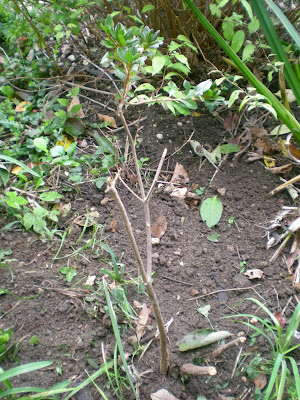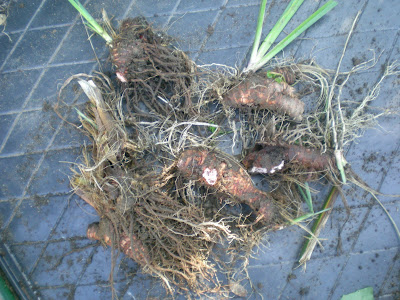When you go to the roadside garden center to take advantage of the Fall plant sales, remember that you have to prepare a space for them and dig a lot of holes!
I got up early and looked at my pile of new plants that needed homes in the Jarvis House Garden. Putting the plants in my wagon was a start. The newbies required a variety of conditions, some would do well in the swampy or boggy areas, while others needed more drainage and sun.
The area of the Jarvis garden that needed attention was on the side of the driveway. It was loaded with bloomed out iris and day lilies. The garden had a few Azaleas and a Hibiscus, but it needed something that would show a little color in the Fall.
I got out my garden cart for the debris, the wheelbarrow, my spade for splitting the clumps of lilies and iris, a shovel for digging the holes, an old pair of garden sheers for trimming the green parts, a pair of clippers of for trimming the azaleas and other woody stems, plastic pots for sorting the clumps, and a small wire rake.
The first thing to move was a struggling Azalea which I re-planted and gave more space near the Quince tree.
Once that was out of the way, all of the plants were removed with the exception of the Azaleas and a white Peony plant.
The cart was quickly filled with clippings and weeds.
Experimenting with the new locations of the additional plants, I realized that the new Callicarpa might crowd the Azaleas.
Since the plants have been in the black plastic pots for who knows how long, it is necessary to lay them on their side and roll them while tapping the side of the pot. This will loosen the roots from the pot and make it much easier to remove.
Probably, the plants are pot bound, so please gently tease them with a trowel or make a few jabs with the spade or shovel to relax the roots.
The first hole that I dug would put this shrub too close to other plants. I have a mature Callicarpa which gave me the true eventual dimension of the plant.
I moved it back, then
I moved it back some more. The depth of the hole was to the top of the plant's soil height.
Next I tackled the clumps of day lilies and iris. Here's where a really good old spade comes in handy. Don't be afraid to just lay the clumps on their sides and place the blade of the spade into the clump and give it a good push with your foot to divide. Sometimes the fingers of the day lilies may get chopped off, but you can be sure that the plant will be better off now that it has more room to breathe, and you can give away any bits and pieces that are broken off.
These are the roots of the Japanese Iris. I use a very nice old pair of sheers to cut the tops short and to remove any dead foliage.
These are the roots of the Yellow Flag Iris. They are much larger and look a bit pink.
The Japanese Iris should be planted in shallow pits, but the Yellow Flags need to be a deeper, due to the fact that their stems and leaves are so top heavy. This might prevent them from flopping over somewhat.
A plant that needs moist soil is the Houttuynia corsata Chameleon, which is a viney ground cover that has a very interesting array of colors. White, pink and vivid red is splashed on heart-shaped leaves. It also has tiny white flowers. This plant is invasive so be careful where you dig It in. It can spread rapidly, but I like it because the fuchsia splashed on the leaves is so beautiful. I put it in the lowest part of the garden which floods occasionally.
The Ligularia is partnered with a hosta under the Quince tree where small seasonal ponds occur in the winter. This boggy plant can spread and has large leaves and a stalk of orange-yellow flowers in late summer.
Now the driveway garden has been re-planted and should be more interesting as a twelve month garden, each season something will bloom.
The shrub with the orange bade-like leaves is a Asclepias incarnata (Soul Mate) or Milkweed, which was labeled "Swamp Weed." Anything with a name like that I plant. It should bloom with long-lasting pink flowers from July trough September. I re-planted the Hibiscus and staked it with an old plant stand.
This was another sale plant, Heliopsis "Summer Sun" that was not in the Jarvis Garden. It is very tall so I placed it near the mailbox with other full sun plants.
Now I have other plants to find places for, but that is another day's work I started out at 8:00 am, and came inside at 2:00 pm, but it was worth it. A few hours of hard work will yield years of pleasure.























2 comments:
You have been busy! Your garden is going to be even more beautiful next spring!
That's a lot of work! And a great spring to look forward to.
Post a Comment